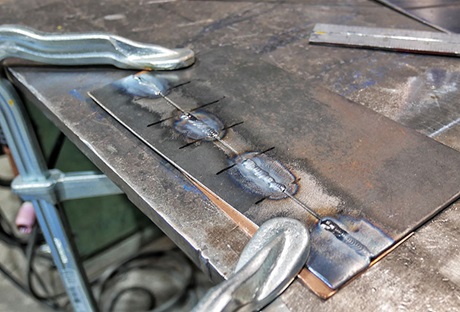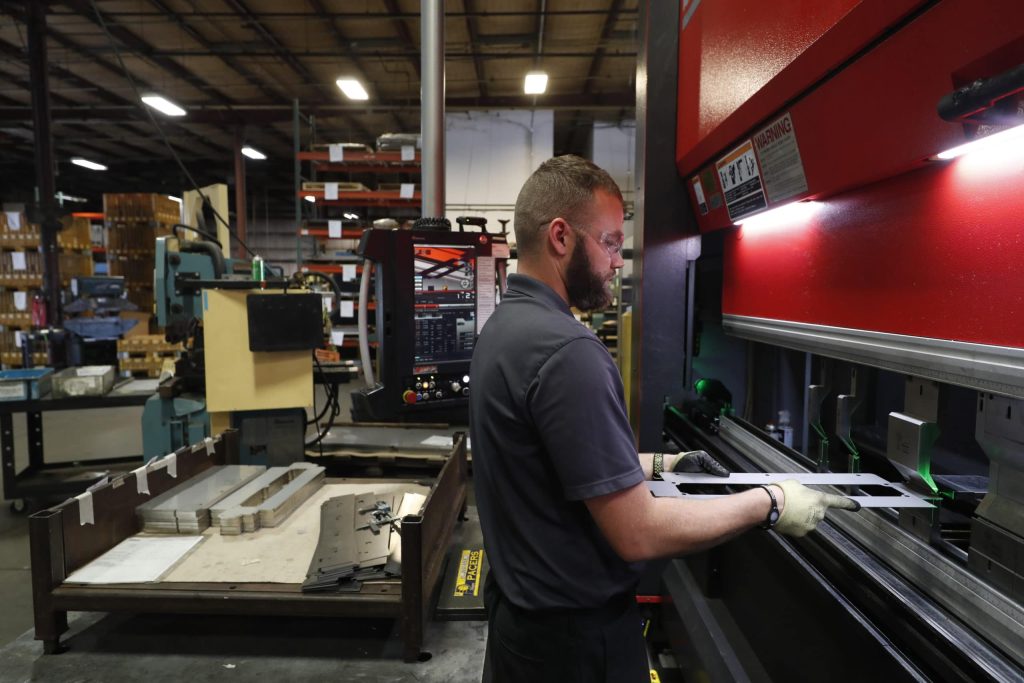Table of Contents
Mig welding is a popular method of joining sheet metal together. However, many people struggle with this process, as it requires a certain level of skill and knowledge. If you’re looking to improve your welding skills and learn how to Mig weld sheet metal, you’ve come to the right place!
In this article, we’ll take you through the basics of Mig welding and provide you with tips and tricks for welding sheet metal. Whether you’re a beginner or an experienced welder, you’ll find plenty of useful information here to help you improve your craft and achieve high-quality welds on your sheet metal projects. So, let’s get started!
- Prepare the work surface and make sure it is clean and free of rust or paint.
- Adjust the wire feed speed and voltage on the welder to the recommended settings for sheet metal.
- Hold the gun at a 90-degree angle to the sheet metal and start welding from the edge, moving in a straight line.
- Use a back and forth motion to create a series of overlapping circles to ensure proper penetration and fusion of the metal.
- Finish the weld by clipping the wire and grinding down any rough edges.
How to Mig Weld Sheet Metal?
Mig welding is a popular welding technique that can be used to weld different types of sheet metal. It’s a process that involves using a wire electrode to heat the metal and fuse it together. Here is a guide on how to Mig weld sheet metal.
1. Choose the Right MIG Welding Machine
The first step in Mig welding sheet metal is to choose the right machine. You need a machine that can handle thin sheet metal, so look for one with a low amperage range. A machine with a range of 20-140 amps is ideal for welding sheet metal.
When choosing a machine, make sure it has a wire feed control that allows you to adjust the speed of the wire. This will help you to control the heat input and avoid overheating the metal.
2. Select the Right Wire and Gas
The next step is to select the right wire and gas for your welding project. For sheet metal, a 0.023 or 0.024-inch wire diameter is ideal. You can use either solid or flux-cored wire, depending on the thickness of the metal.
As for the gas, a 75% Argon and 25% CO2 mixture is recommended. This gas mixture will provide good penetration and a clean weld.
3. Prepare the Sheet Metal
Before you start welding, prepare the sheet metal by cleaning it thoroughly. Use a wire brush or grinder to remove any rust, paint, or other contaminants. Make sure the metal is clean and dry before you start welding.
4. Set up Your Welding Area
Set up your welding area in a well-ventilated space. You should also make sure you have a fire extinguisher nearby in case of an emergency. Wear protective clothing, including gloves, a welding helmet, and a welding jacket.
5. Position the Metal
Position the sheet metal in the right spot for welding. Use clamps or magnets to hold it in place. Make sure the metal is flat and level before you start welding.
6. Set the Wire Feed Speed and Voltage
Set the wire feed speed and voltage on your welding machine based on the thickness of the metal. Use the manufacturer’s recommendations as a guide. You may need to adjust the settings as you weld.
7. Start Welding
Start welding by holding the gun at a 15-degree angle and pulling the trigger. Move the gun steadily along the joint, keeping the wire at a consistent distance from the metal. Use a back-and-forth motion to fill the joint with weld metal.
8. Control the Heat Input
Control the heat input by adjusting the wire feed speed and voltage. You want to avoid overheating the metal, which can cause warping or burn-through. Move the gun quickly to avoid overheating the metal.
9. Finish the Weld
Once you’ve filled the joint with weld metal, finish the weld by using a wire brush to remove any slag or spatter. Inspect the weld for any defects or cracks.
10. Benefits of Mig Welding Sheet Metal
Mig welding sheet metal is a quick and efficient way to join two pieces of metal together. It produces a clean and precise weld that is strong and durable. Mig welding also allows you to weld in any position, making it versatile and easy to use.
In conclusion, Mig welding sheet metal requires some skill and practice, but it’s a useful technique to learn. By following these steps and using the right equipment, you can produce high-quality welds that will last for years to come.
Frequently Asked Questions
Here are some common questions regarding how to Mig weld sheet metal.
What is Mig Welding?
Mig welding stands for Metal Inert Gas welding, which is a type of welding process that uses a wire electrode to fuse two pieces of metal together. This process is typically used in automotive and manufacturing industries, as well as in home repair projects.
The process involves feeding a wire electrode through a welding gun and then using an electric arc to melt the metal and fuse it together. The welding gun also releases a shielding gas, which protects the molten metal from contamination.
What is Sheet Metal?
Sheet metal is a type of metal that is thin and flat. It is often used in the manufacturing of products such as car parts, appliances, and HVAC systems. Sheet metal can be made from a variety of materials, including steel, aluminum, copper, and brass.
When it comes to welding sheet metal, it is important to use the appropriate welding technique and equipment to prevent warping, burn-through, and other issues that can compromise the quality of the weld.
What type of Mig Welder is best for Sheet Metal?
When it comes to welding sheet metal, a MIG welder with a low amperage setting is best. This is because sheet metal is thin and can easily be damaged by high heat. A welder with a lower amperage setting will allow you to weld the sheet metal without causing warping or burn-through.
Additionally, it is important to use a welder with a high-quality wire feed system to ensure a smooth and steady flow of the wire electrode. This will help to prevent interruptions in the welding process and ensure a consistent weld.
What are some Tips for Mig Welding Sheet Metal?
When Mig welding sheet metal, it is important to use a low amperage setting and a short arc length to prevent burn-through and warping. Additionally, you should avoid welding in the same spot for too long, as this can cause the metal to overheat and deform.
It is also important to use the right type of wire and shielding gas for the job. For sheet metal, a thinner wire and a gas mixture with a higher percentage of argon will provide the best results.
What are the Benefits of Mig Welding Sheet Metal?
Mig welding sheet metal offers several benefits, including a strong and durable weld that can withstand stress and strain. Additionally, Mig welding is a fast and efficient process, which can help to save time and money in manufacturing and repair projects.
Furthermore, Mig welding is a relatively easy process to learn, making it accessible to both professionals and DIY enthusiasts. With the right equipment and technique, anyone can learn how to Mig weld sheet metal and achieve professional-quality results.
In conclusion, mastering the art of MIG welding sheet metal can be a valuable skill for any DIY enthusiast or professional welder. By following the steps outlined in this guide, you can learn to create strong and precise welds on thin sheets of metal.
Remember to take your time and practice on scrap pieces before attempting to weld your actual project. This will help you develop your technique and ensure that your final welds are both aesthetically pleasing and structurally sound.
Overall, MIG welding sheet metal requires patience, skill, and practice. But with dedication and the right tools, anyone can learn to weld like a pro. So why not give it a try and see what you can create? With a little practice, you may just become a master of the craft.
Request a quote today!
[contact-form-7 id="1578" title="Contact form"]
Please compress the file into a ZIP or RAR file before uploading. Alternatively, send through your RFQ by email.
enquires@unitymanufacture.com




